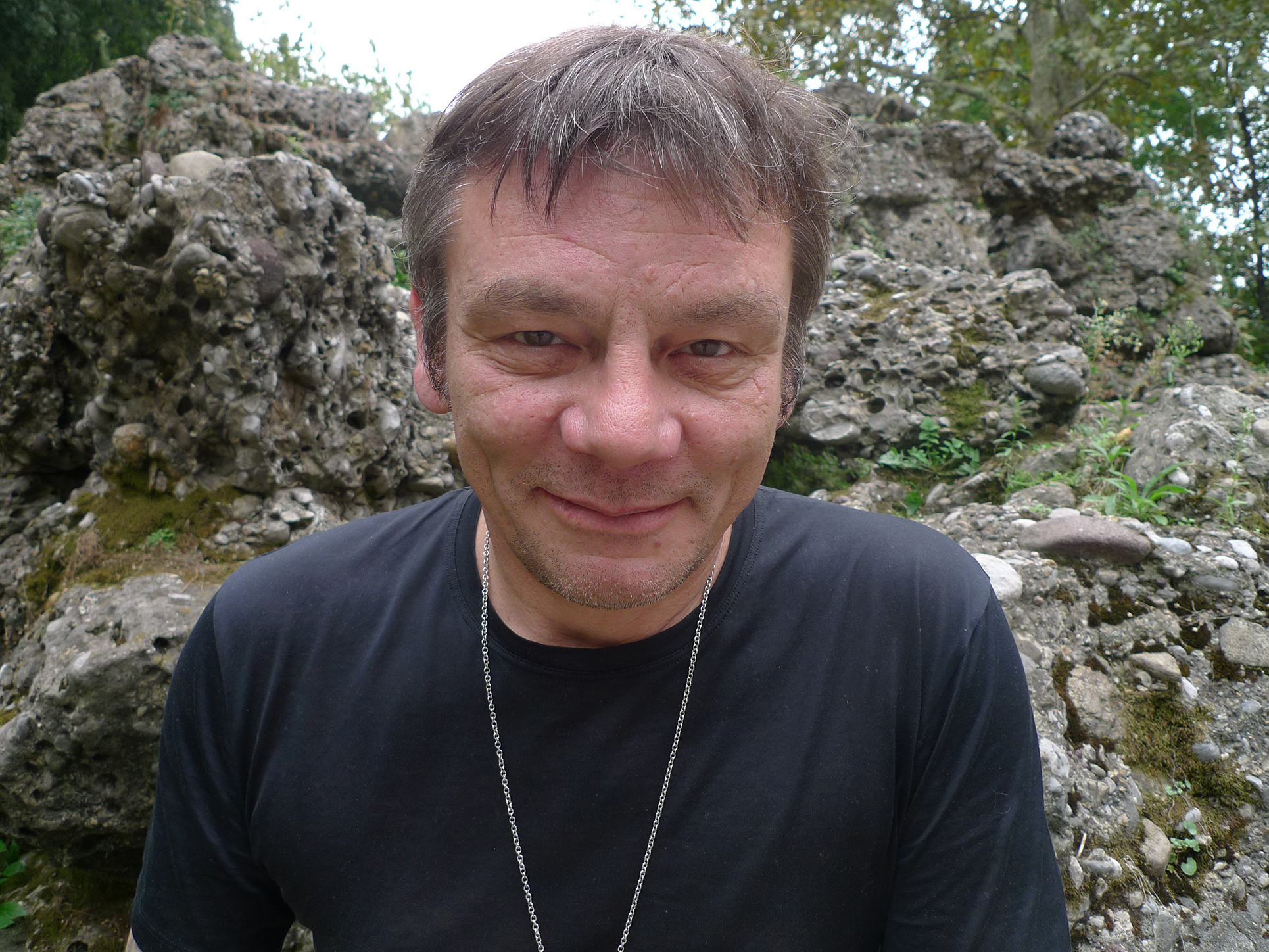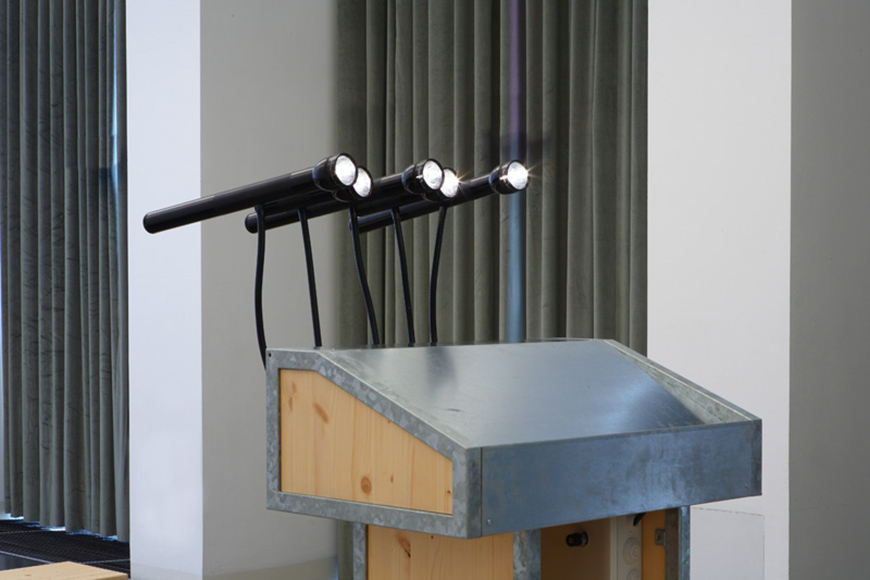I fight for my Liberty
The installations of Fabrice Gygi – Genevan artist, class of 1965 – plunge us into a situation of strange ambiguity and discomfiting unease. Are we at a show of furniture design, or have we ended up in the military depot of some unknown totalitarian state by mistake? Is this arsenal of equipment perhaps used by the forces of law and order to bring under control the uprisings of an enraged population, or else does it form part of a refuge where the clandestine rebels are hiding? The structures leave us in doubt: Gygi avowedly prefers not to reveal his position. In fact his minimalist objects with a simple but effective aesthetic refrain from any decoration: they are the archetypical trappings of power which are born out of an accurate observation of reality. Fabrice Gygi calls himself a hyperrealist, and through his sculptures highlights the universal value of the mechanisms of power.
At the Milan branch of the Istituto Svizzero di Roma (‘Swiss Institute of Rome’), the Genevan sculptor has on display two installations from 2007, which speak of an apparently less violent aspect of power. Meeting Room and Conference Room seem to represent the furnishings of a meeting room and a conference room of a multinational company, or perhaps a consulate. It is only on a second look that you notice details which instead evoke a subtle and manipulative atmosphere of violence. The entrance to Meeting Room is blocked by an anti-crowd barrier in lacquered steel, and the microphones attached to the stand of the lectern prove to be the torches of the security forces. The thing that resembles a microphone has had its function of amplifying a speech removed, and instead is used as a spotlight on the person performing in front of the public, a public which has not been invited to the meeting and hence cannot participate in the decision-making. Besides, not a single speech will be heard at the press conference: we are restricted to admiring the external images of power which are manifested on the stage.
Barbara Fässler: Fabrice, your first solo exhibition in Italy is to open today, and the venue is neither a gallery nor a museum, but rather a cultural space which represents Switzerland in Italy. In the past you have already had the opportunity of representing your country at the biennials of Cairo, San Paulo and Venice, so you have some experience… Doesn’t this status scare you? Are you not afraid of losing your critical outlook?
Fabrice: No, I really don’t think so. The only risk is to become an Official Artist for real (laughing), but I do not fear that my works could lose their critical strength. Rather, the astounding thing is that Switzerland still allows this kind of position of self-criticism. The only worry is that of having the Swiss flag glued onto my back.
B.F: So what would it mean for you to become a Swiss Official Artist?
F.G.: In a way I am already that and have been for some time, but I don’t find that onerous. While I have the liberty to do other things, it’s all fine.
B.F: In Milan you are putting on show two installations from 2007, specially adapted for the exhibition space: Meeting Room and Conference Room. These works investigate a more subtle aspect of power, drawing comparison, for example, with the anti-riot barriers which have been used in the past: here we are not speaking of the violence of power, but about its mental impact through propaganda. The Meeting Room is where brain-washing is prepared. The question remains open, however, how will the public be able to distinguish a genuine Meeting or Conference Room from your minimal works of art which aim to be a biting criticism of the structures of authority?
F.G.: There are, in effect, certain details that allow one to see that this is the work of an artist. On the one hand there are the barriers which lead us to think of a discourse on authority, on the other hand there are the microphones-torches which cannot carry out their original function.
B.F: Therefore you limit yourself to observation, or is there a creative side, a “Style Fabrice” in your work?
F.G. (laughing): There definitely is a “Style Fabrice”, seeing that I design everything and I never make reproductions of photographs. I simply think of a ‘meeting room’ and I design a meeting room, or I think of a ‘barrier’ and I design one. I am approaching a kind of Low Design: I produce my own personal arsenal where you may find a Meeting Room, a courtroom, a bar, a mobile snackbar, an airbag…
B.F: …an arsenal of tools, methods and representations of power…
F.G.: …yes, and for the management of body and mind.
BF: Marc-Olivier Wahler picks up in your work an ambiguity between authority and resistance which is never resolved. Your tents, for instance, could be used as structures for popular festivals, but equally as a travelling courtroom. What is your position? What is your message?
F.G.: No position, no message.
B.F: Yes, I was expecting this answer (laughing). Isn’t it too easy?
F.G.: No, I don’t think so, because we live surrounded by ambiguity, hence it is normal that things are ambiguous. That which I try to reveal, rather, is that power and resistance have similar ways of functioning.
B.F: Do not these apparent contradictions, which are expressed both formally and in the structures that can be contructed and dismantled, inflated and deflated, movable and fixed, serve to handle a permanent state of crisis better?
F.G.: This idea emerged in the underground milieu of the 90s, when they said that things should remain mobile: in order to remain free, we should stay mobile! It’s the only means of escape.
B.F: Like hares…
F.G.: …(laughing), yes, exactly, and that’s why my pieces have always been movable. This principle also functions in the world of art: an inflatable object takes up less space in the warehouse. The logic of the material is married to the idea of mobility.
B.F: Somewhere you once said that you “…question the author ity and the order that are a threat to liberty. There is no rebellion, but only an observation.” Do you therefore accept the way things are, or are you interested in designing a utopia which would be above criticism?
F.G.: In effect, the pieces function as a kind of observation. It’s nothing to do with a rebellion at all, I don’t have any solutions, nor am I making a moral judgment. I am only saying: be careful with the State. A tomorrow could come when they return to building death camps. You need to be wary. This is why I fight for my liberty.
B.F: There you are, but this fight for liberty, couldn’t it turn into a utopian vision? I am thinking, for example, of Slave City by Joep van Lieshout, even though, in effect, this work has an extremely cynical side to it.
F.G.: Yes, and takes on something of caricature. I could take all this stuff and say: I am producing my arsenal, I have my flags, my little bits and pieces, now I am off to devise my table of laws, I am going to employ people, I am going to make a proper community… No, I don’t think so. On the contrary, I am an artist, I am an individual, I produce works, but I have no wish to enter into any sort of pretense or film.
B.F: NO FUTURE ?
F.G.: None of my works ever lay claim to the hypothesis of a [particular] territory reserved for anarchists. For me, each individual has to fight for themselves on their own. I am very much an individualist. Rather, we can say that I demand this individual liberty.
B.F: What is the relationship between your installations and the public? Do you envisage a direct and one-directional enjoyment like that of a sculpture, or do you invite people to interact with the pieces in a kind of participatory enjoyment?
F.G.: I prefer that the viewers keep their place: I absolutely do not tolerate participation.
B.F: Excluded by the barricade.
F.G.: Yes, in effect the barricade pushes them into a position which obliges them to look at the installation like a picture, a painting, or even a sculpture. The device clearly states that the people who enter the space do not participate in meetings: if they have access to any part, it’s only to the conference.
B.F: You declare yourself as being a realist: where then is to be found the boundary between a representation of reality and an ironic position which quotes that which it criticises?
F.G.: There you are – this is the reason why I have never created any readymades, for example. The act of designing and constructing objects is of great importance to me. To make sculptures is not the same as moving about an object in a museum.
B.F: In my opinion, however, there is a tiny kinship with readymades.
F.G.: I really don’t believe that there is, because I maintain more the position of a hyperrealist painter. I seek to create ambiguity, a kind of camouflage in which the viewers ask themselves whether they are dealing with a work of art or something that somebody has forgotten and left behind there. One of the first pieces that I ever made was a platform, positioned in an enormous hall during an art competition. The viewer could really have thought that it had been placed there by the public utilities.
B.F: So the ambiguity also plays on the difference between real life and art.
F.G.: Yes, each time you don’t know what status to assign to it.
B.F: In a few days’ time, in front of the stock exchange of Milan they are going to unveil a marble statue by Maurizio Cattelan. We’re talking of a raised middle finger… What do you think of this sort of “social commentary” which is mainly perceived as a public provocation? Have you ever been tempted to do something similar?
F.G.: I do think that the role of the artist is to be provocative, Maurizio in his own way, I in mine. And the message is clear: to say ‘fuck’ to the stock exchange. But ‘fuck’ – what for?
B.F: An artist such as Cattelan who sells at auctions for eight million and who has himself become “a subject of speculation”…
F.G.: Oh yes, quite so. This is perhaps his way of taking us for a ride. You will see that in the end we’ll be talking about the economy and the art market. That kind of position doesn’t interest me much.
B.F: Have you ever been censored?
F.G.: There is direct disapproval – genuine censorship – and then there are the little reprimands. Often I have met with some refusals, but mostly this was where institutions who self-censored themselves were concerned. There has never been a state institution which has refused a work or closed an exhibition. In Venice, yes… But this isn’t real censorship, such as, for example, when the curia told me that I was being an apologist for the profanation of graves and tried to recast the project.
B.F: That’s participation…
F.G.: …not exactly. They were pushing for a compromise that would have destroyed the piece… To return to the example of Cattelan: I don’t know the project, but in these cases it is very important to understand who is paying, who is authorising the work, who is behind it. That is, who has sufficient power and money to impose this work on a public space, in front of the stock exchange moreover. And, in my view, it is precisely this angle which becomes interesting and ironic: much more so than that raised finger.
BF: Thank you very much.
Barbara Fässler

